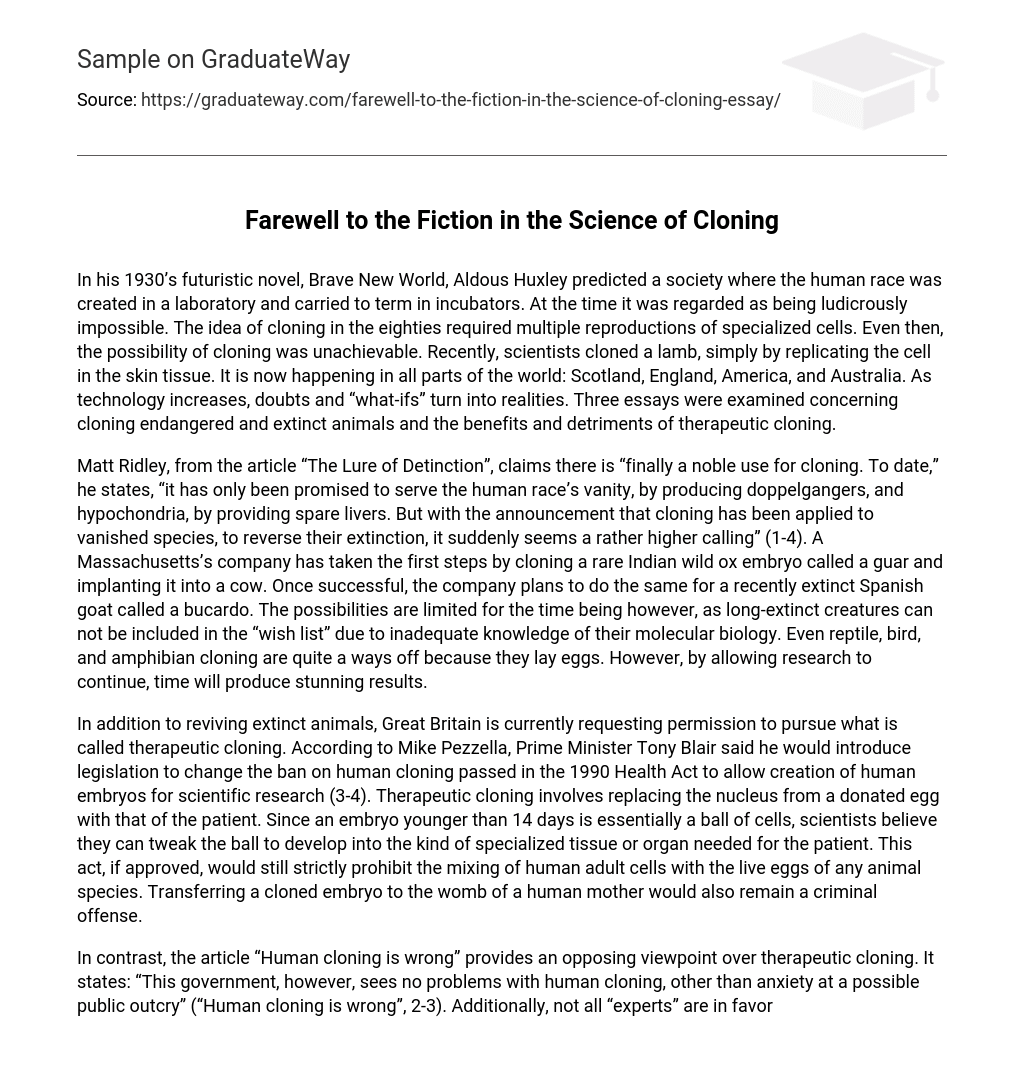In Brave New World, a novel written by Aldous Huxley in the 1930s, the author predicted a society where humans are created and developed in laboratories using incubators. This concept was once deemed impossible but recent advancements in cloning technology have made it a reality. In the 1980s, cloning was considered unachievable due to the need for replicating specialized cells multiple times. Nevertheless, scientists have successfully cloned a lamb by duplicating a cell from its skin tissue. Currently, countries like Scotland, England, America, and Australia are conducting cloning research globally. As technology progresses, what were once uncertainties and hypothetical situations are now becoming actualities. This essay examines three works that discuss the cloning of endangered and extinct animals as well as the pros and cons of therapeutic cloning.
According to Matt Ridley, in his article titled “The Lure of Detinction”, cloning has previously been used for vanity and hypochondria, but now it has a higher purpose: reversing the extinction of vanished species. A company in Massachusetts has started this process by cloning a rare Indian wild ox embryo, called a guar, and implanting it into a cow. The next step is to do the same for an extinct Spanish goat called a bucardo. However, there are limitations at the moment because the molecular biology of long-extinct creatures is not well understood. Cloning reptiles, birds, and amphibians is also a distant possibility since they lay eggs. Nonetheless, by allowing research to continue, significant results can be expected in the future.
Great Britain is currently seeking permission to practice therapeutic cloning, alongside their efforts to bring back extinct animals. Prime Minister Tony Blair announced plans to change the ban on human cloning, allowing the creation of human embryos for scientific research. Therapeutic cloning involves replacing a donated egg’s nucleus with that of a patient. Scientists believe that by manipulating the embryo, they can develop specialized tissue or organs for the patient. However, the proposed legislation would still forbid the mixing of human adult cells with live eggs from animals, and it would continue to be illegal to transfer a cloned embryo into a human mother’s womb.
The article “Human cloning is wrong” presents an opposing viewpoint on therapeutic cloning. According to the article, the government does not see any problems with human cloning except for potential public outcry. It also mentions that not all experts support this field and refers to the Donaldson committee, which was established due to discrediting of the government’s consultative procedure by the pharmaceutical industry’s influence. The pharmaceutical industry stands to benefit greatly from “therapeutic” cloning. The article argues against lifting the ban on human cloning since it would encourage alternative technologies like Adult stem cell research. The author concludes by stating that the term “therapeutic” is misleading as it is not therapeutic for the embryo, but rather cannibalistic.
After reviewing the information, I have concluded that cloning, including both therapeutic and reproductive methods, is vital and unavoidable, excluding human reproductive cloning. The article by Matt Ridley demonstrates that the technology is readily accessible. We have successfully cloned rare goats in the womb of a cow, and nearly all domesticated animals have been cloned. The evidence is abundant: the first cow was cloned successfully years ago and continues to thrive. Concerns about “shorter cloned life expectancy” are unfounded. In one instance, the cells of six cloned calves lived twice as long as calves produced through sexual reproduction. Additionally, it is possible to revive certain species that humanity has eradicated without harming the well-being of existing animals. Some argue that investing more money into reproductive cloning will deplete funds for protecting endangered species. If this is true, then there was never sufficient funding available in the first place. As for therapeutic cloning, Dr. Liam Donaldson, Britain’s Chief Medical Officer, personally presented a recommendation to lift the ban on therapeutic cloning research to the Prime Minister, as described in “UK gives OK to human cloning for research” by Pezzella. This action clearly indicates Dr. Donaldson’s belief in and support of the cause. The essay titled “Human cloning is wrong” presents arguments that I find biased and judgmental.The essay proposes abandoning therapeutic cloning in favor of adult stem cell cloning, despite the risk of prematurely dismissing a promising treatment. Such a decision would be contrary to intellectual and scientific principles. As pointed out by Dr. David Turner, attempting to reverse the progress made in cloning, exemplified by the creation of Dolly the sheep, would be futile.
The controversy surrounding cloning encompasses a wide range of topics. While some believe that cloning will have predominantly negative consequences, this is not entirely accurate. If therapeutic and reproductive cloning are carefully supervised and governed, only positive outcomes can be expected. Having thoroughly examined this subject, I find it futile to overlook this technology or to oppose it. Whether officially endorsed by the authorities or conducted secretively in labs, cloning is inevitable and should happen.





